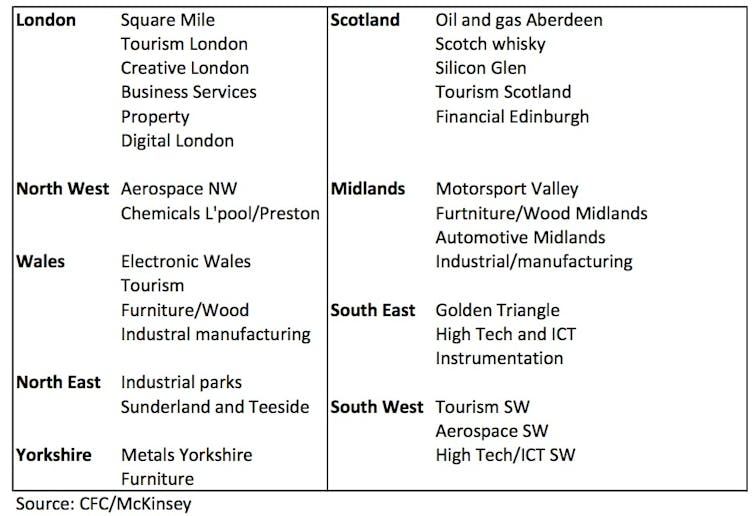Silicon Valley is the classic example of a business cluster. Less well known but also very successful are the machinery and agriculture clusters in Emilia-Romagna in northern Italy. Naturally the UK also boasts a fair few of these too – groups of businesses in the same or related sectors which are concentrated in a particular location. The Square Mile in London, for example; the Yorkshire metals industry and the so-called Motorsport Valley hub around Silverstone in the Midlands.
Clusters were the subject of a new 86-page report by the Centre for Cities think tank and McKinsey, the management consultancy. Commissioned by former science minister Lord Sainsbury, it identified the UK’s 31 most economically significant clusters and underlined their ongoing importance to the economy: they account for 8% of UK businesses yet generate 20% of national output. They employ more than four million people, typically with higher average salaries than their neighbouring (non-clustered) regions.
The UK’s Top 31 Clusters

Research into clusters is not new. Since the late 1980s our understanding of them and how they operate has developed significantly. Largely due to the influence of the Harvard professor Michael Porter, the concept has assumed an important place in the policy domain.
Curious phenomenon
Academics were originally interested in answering why we still observe specialised clusters of economic activity in developed countries, when you might have thought it would make sense in a globalised economy to relocate them to places where the labour costs were lower. In fact they seem (relatively) immune to these cost competitive forces.
The answer is that clusters have inherent competitive advantages. These typically include a set of interlinked institutions, facilities, skills, informal networks and critically, knowledge bases. You end up with an “industrial atmosphere” where the firms can benefit from knowledge spillovers. This encourages them to experiment, innovate, and gain competitive advantage through higher value-added activities. In turn this helps them to exploit new market opportunities.
By the late 1990s, countries like the UK were developing policies that promoted clusters with a view to boosting regional growth. This became one of the key remits of New Labour’s regional development agencies in England and Wales and in 2001, the department for trade and industry published the first systematic mapping and assessment exercise into the phenomenon.
The EU also began to earmark significant funding for cluster development through the framework programme and structural funds. Clusters remain a priority for the coalition government, although policy has become more fragmented. It is now managed through local economic partnerships, while the funding is allocated through the City Deals programme.
Do clusters pass muster?
The new Centre for Cities/McKinsey report focuses largely on the barriers to future cluster growth, many of them identified from conversations with business leaders in several leading clusters. A major weakness appears to be a lack of identity. While the UK has some internationally recognisable clusters such as London’s financial services, Motorsport Valley, the Scottish whisky industry, and even the re-emerging North Staffordshire ceramics cluster, many others are not well known as clusters – sometimes even among those companies who are part of them.

This can mean that firms miss an opportunity to market themselves as part of a branded cluster. Lack of identity can also reduce clusters’ potential to attract inward investment and the ability of firms to act in unison, including gaining the necessary recognition to successfully bid for state support.
This largely reflects the problems in actually defining a cluster, as the report acknowledges. The academic literature is not particularly helpful here. It sometimes focuses on the spatial boundaries of the industrial activity, rather than the extent to which firms in related sectors are embedded in localised networks. This distinction is important, since potential cluster benefits may not be realised if there is not a good network.
The new report’s mapping exercise appears to adopt this spatial boundaries approach. Thus there are two aerospace clusters (in north west and south west England) and several tourism clusters. In other cases it gives clusters generic labels such as “high tech”, “electronics” and “industrial manufacture”, even though each of these covers numerous different firms and sub-sectors.
Yet it is unclear to what extent these clusters are actually networked. In the aerospace and automotive industries, for instance, it might be more appropriate to think in terms of a pan-European wide cluster of (networked) activity. Getting your cluster boundaries right is vital for policy, particularly in light of the report’s other suggestions to establish a minister for clusters, with associated cluster league tables, and the implications these have for the allocation of state resources.
Network links
Nevertheless the report does highlight some longstanding weaknesses in UK policy regarding local and external networks. It usefully suggests strengthening local networks and fostering greater external links; creating new links between UK clusters and possibly creating “global peer clusters” to foster mutual learning and share best practices.
This is designed to combine external knowledge with the “local buzz” of a cluster, which helps the firms involved to avoid becoming over-embedded and locked in to redundant ideas and technologies. There are numerous international examples of successful cross-border cluster links that are mutually beneficial. One is the ceramic tile clusters of Castellon (Valencia in Spain) and Sassuolo (Emilia-Romagna), which share technical knowledge, machinery and materials.
The report also calls for universities to play a larger role in cluster dynamics by commercialising their innovations and encouraging spin-off companies. The US has long been a leader in this regard, although the UK has some notable successes, such as Cambridge’s Silicon Fen.
The report proposes that other local education institutions work more closely with clustered firms to tailor courses and training schemes to reduce skills gaps, alongside mentorship programmes to assist new local entrepreneurs. It also rightly stresses that any policy responses need to be tailored to suit local circumstances and avoid the dreaded “one size fits all” approach.
Both the leading parties have been emphasising the importance of local economic development lately. Ed Miliband has been promising to focus on localism, while David Cameron has been talking about extra investment for the regions. In this climate, and with manifestos for next year’s general election around the corner, the new report will certainly provide plenty of food for thought.

